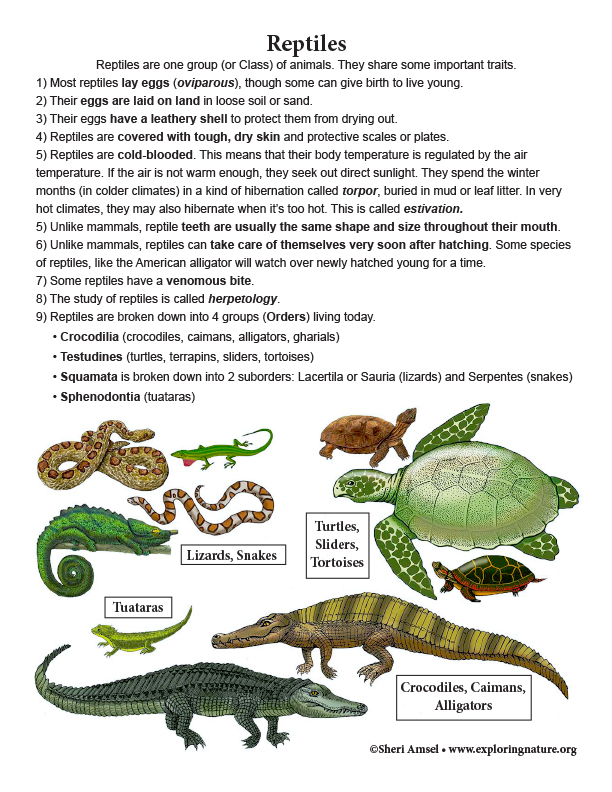

Phylum: Chordata
Class: Reptilia
Reptiles are one group (or Class) of animals. They share some important traits.
1) Most reptiles lay eggs (oviparous), though some can give birth to live young.
2) Their eggs are laid on land in loose soil or sand.
3) Their eggs have a leathery shell to protect them from drying out.
4) Reptiles are covered with tough, dry skin and protective scales or plates.
5) Reptiles are cold-blooded. This means that their body temperature is regulated by the air temperature. If the air is not warm enough, they seek out direct sunlight. They spend the winter months (in colder climates) in a kind of hibernation called torpor, buried in mud or leaf litter. In very hot climates, they may also hibernate when it’s too hot. This is called estivation.
5) Unlike mammals, reptile teeth are usually the same shape and size throughout their mouth.
6) Unlike mammals, reptiles can take care of themselves very soon after hatching. Some species of reptiles, like the American alligator will watch over newly hatched young for a time.
7) Some reptiles have a venomous bite.
8) The study of reptiles is called herpetology.
9) Reptiles are broken down into 4 groups (Orders) living today.
• Crocodilia (crocodiles, caimans, alligators, gharials)
• Testudines (turtles, terrapins, sliders, tortoises)
• Squamata is broken down into 2 suborders: Lacertila or Sauria (lizards) and Serpentes (snakes)
• Sphenodontia (tuataras)
When you research information you must cite the reference. Citing for websites is different from citing from books, magazines and periodicals. The style of citing shown here is from the MLA Style Citations (Modern Language Association).
When citing a WEBSITE the general format is as follows.
Author Last Name, First Name(s). "Title: Subtitle of Part of Web Page, if appropriate." Title: Subtitle: Section of Page if appropriate. Sponsoring/Publishing Agency, If Given. Additional significant descriptive information. Date of Electronic Publication or other Date, such as Last Updated. Day Month Year of access < URL >.
Amsel, Sheri. "ABOUT REPTILES" Exploring Nature Educational Resource ©2005-2024. December 13, 2024
< http://www.exploringnature.org/db/view/ABOUT-REPTILES >
